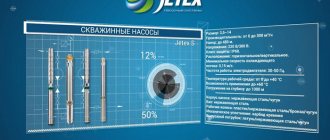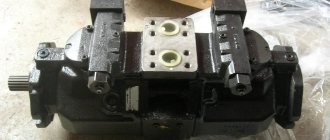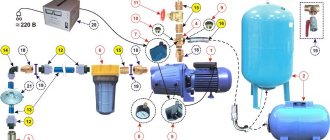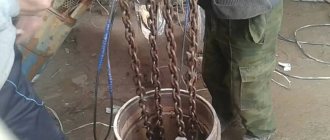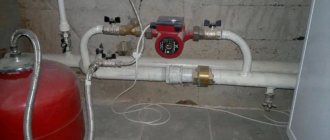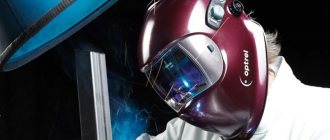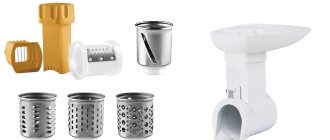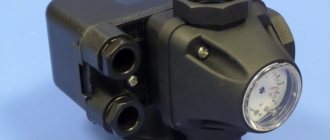From the article you will learn how to choose a pump for a well, popular models and the best solutions for irrigation, home water supply, and so on. Recommendations for choosing different amounts of fluid to consume will be provided. It is important to choose the right equipment and additional components that will help fill all containers with water in a few minutes.
Deep pumps Source planetsad.ru
Model differences
To understand which pump to choose for a well, you need to understand their differences:
- Superficial . They are mounted near the source and operate on the principle of suction. The level of lift affects the efficiency of performance indicators. Used for depths of no more than 8 meters. The models are very noisy, so it is recommended to install them in a separate room or close them.
Surface aggregate Source aquatools.com.ua
- Submersible . They sink almost to the very bottom. The best option for artesian and filtration wells. They operate on the principle of pushing out liquid. When choosing, you need to take into account the height to which the water supply is planned - the maximum is 40 m; for larger ones, more powerful models are used.
When selecting a centrifugal model, a number of important indicators must be taken into account: productivity, maximum working depth, dimensions, operation and installation. Manufacturers indicate the characteristics of devices in the data sheet. Submersible models are considered very reliable; they have a specific body made of steel. Suitable for use in constant damp conditions, they guarantee a stable fluid supply.
The technical data sheet for each pump model must indicate its maximum performance. Devices of different power also differ visually. Submersible high-performance models are heavier and larger in size. Experts recommend choosing products with a reserve level of performance and equipped with additional protection functions.
High-performance submersible unit Source stark.dk
A submersible pump for a summer residence can be vibrating or centrifugal. It should be noted that a centrifugal pump for a well supplies liquid using a disk with small blades by rotating it. Vibrating ones have a membrane installed that produces vibrations. They are distinguished by productivity, ease of operation, favorable price and are suitable for almost all wells. However, experts do not recommend their use, since vibration accelerates the processes of siltation and destruction of the casing. But if everything is done correctly and the equipment is selected correctly, then these processes are not so fast.
Centrifugal device Source mir-bureniya.com.ua
There are inexpensive and popular domestically produced vibration water pumps for wells. They are characterized by high performance characteristics and good productivity. The models are high quality and durable.
Differences between surface and submersible units
The entire range can be divided into 2 types of pumps: surface and submersible.
Surface equipment is mounted in 2 ways:
- installed next to the well on the ground;
- fixed on special floats and lowered into the well (on the surface of the water).
Nuances of surface pumps
The principle of operation of such a unit is to suck up liquid without immersing the unit in water.
These devices are low cost and easy to maintain, but they are not suitable for all wells. The distance to the water surface should not exceed 8-10 m. Otherwise, the performance of the device is sharply reduced. Surface devices are best suited for Abyssinian wells (shallow and narrow).
Another disadvantage of surface devices is the high noise level. To solve this problem, experts recommend installing a wooden box on top of the unit or carrying out installation in a separate room (utility room).
Features of submersible pumps
Unlike the previous model, submersible pumps are lowered into the well. Their task is to push water from the bottom to the surface of the earth. In this case, the list of main characteristics of the device will include the maximum depth at which the equipment can operate.
To determine the best option, another 2 m is added to the dynamic level of the well.
Manufacturers of submersible systems offer 2 main types of devices:
with low power (suitable for work at depths up to 40 m)
with high power (necessary for extracting water from depths exceeding 40 m).
For each model, manufacturers indicate the recommended depth at which the device can operate. When purchasing, it is better to choose a device with a “reserve”. So, for a 50 m well, it is better to choose a pump with a 60 m immersion. This will prevent overload.
Some products have automatic shut-off when there is insufficient water. This function increases the cost of the device, but it allows you to extend its service life and protect against breakdowns.
Model selection
Today, manufacturers offer submersible, deep, and borehole pumps for wells. They differ in characteristics, method of application, dimensions and installation method. When choosing a model, you need to consider the following indicators:
- water level;
- bottom base;
- formation depth;
- pipe diameter and other factors.
Specialized companies must provide their clients with a technical passport and indicate in it all the characteristics for the required device. It is important to choose a device whose performance will correspond to the rate of water accumulation. If the unit is very powerful, then the well will quickly empty and the device will run dry, which leads to rapid wear of parts.
Different types of submersible devices Source variant-a.ru
Centrifugal units consist of a wheel and chambers that divide it into stages (from 1 to 4). The wheel has two rims with blades; when rotating, it creates pressure. Models are compact, high-performance. They are characterized by infrequent maintenance, long service life, installation in different wells, but are quite expensive.
Vibrating ones consist of an electromagnet and a vibrator. Vibrations move the piston. Water is drawn into the chamber and then pushed out into the channel. Budget devices are less productive and can work for a long time.
Surface centrifugal unit Source hot-point.com.ua
You can select a surface water pump for your dacha based on certain characteristics and parameters:
- planned watering, keeping animals, livestock, poultry;
- number of family members, water intake points, set of household appliances, plumbing fixtures, presence of a fountain, artificial pond, swimming pool;
- use of one point for several areas, relation to water quality.
Depth models are cylindrical in shape. For the production of the housing, a material is mainly used that is not affected by corrosion. A grate is installed at the bottom for suction and filtration. There can be two types, so which submersible pump for a well is better, screw or centrifugal, must be determined in accordance with the important parameters described below.
Deep aggregates Source frontiersin.org
Sometimes wells are flooded, so it is necessary to install special models, but they are more expensive. It is necessary to abandon rubber hoses and use only plastic structures. When choosing a device, the main indicator is daily water consumption, but it must be remembered that in summer water consumption is always greater than in winter. Also taken into account is the cost of irrigation, animals and other needs, which significantly increase water consumption.
High pressure unit Source bukalapak.com
See also: Catalog of companies that specialize in water supply and sewerage.
Main varieties
Modern Russian and foreign manufacturers offer various types of submersible pumping equipment for equipping wells, which differ in both design and operating principle. When choosing a pump from the variety of options offered on the modern market, you should compare the technical capabilities of such devices with the tasks for which they are planned to be used.
Vibrating
The principle by which a submersible vibration electric pump works is as follows.
- An alternating electric current is passed through the turns of the electric coil, which is the main design element of such a device, which helps create an alternating magnetic field in its core.
- The massive metal armature of the vibration pump, when creating an alternating magnetic field in the core of the coil, is either attracted to this field or repelled from it, performing reciprocating movements with a certain frequency.
- The pump armature is connected through a special rod to an elastic membrane and a piston that moves in the working chamber. When the piston moves downwards, the liquid medium from the well is sucked into the working chamber through the inlet pipe, and when it moves up, it is pushed out of it into the pressure line.
Vibration type submersible pump device
Since the design of a vibrating hydraulic machine does not have an electric motor or rotating components, such equipment is highly reliable and durable. Meanwhile, when choosing a vibration-type submersible pump, you should keep in mind that it cannot create a fluid flow with high pressure and is characterized by rather low productivity. In addition, a vibration-type borehole pump, due to its design features, is critical of solid impurities contained in the pumped liquid medium.
If we talk about the advantages that vibrating deep well pumps have, these include:
- light weight, which makes it possible to use even a nylon cord to place such a device in an underground well;
- low cost, which favorably distinguishes such pumps from submersible pumping equipment of any other type.
Budget vibration pump “Baby”
It should be borne in mind that when a device of this type operates, vibration waves are created in the thickness of the liquid medium in which it is placed, which can lead to the destruction of the unprotected walls of the well and siltation of the pumped liquid.
Centrifugal
The main working unit of the design of centrifugal submersible pumps is a wheel, on the outer surface of which blades are fixed, moving the pumped liquid medium through the internal chamber of the device at high speed. In this case, the liquid is affected by a centrifugal force, pushing it through the pressure pipe. When the liquid medium is thrown towards the walls of the working chamber of the pump, a vacuum of air is created in the center of the chamber, which facilitates the suction of the next portion of liquid through the inlet pipe.
The characteristics of submersible centrifugal pumps for wells (in particular, the liquid flow pressure and productivity created by such devices) can be significantly improved if such equipment is equipped with several impellers located in series on the same shaft. In this case, the pressure created by the pumping equipment is the sum of the pressures generated by each impeller.
Design of a centrifugal borehole pump
Centrifugal pumps, which are among the most popular devices among all submersible pumping equipment used today for wells, are presented on the modern market with a wide variety of models, which allows them to be selected for various purposes. Centrifugal submersible pumps for wells have technical characteristics that make it possible to create a flow of liquid medium with high pressure, as well as pump out liquid from deep underground sources and transport it along a horizontal section of the pipeline over considerable distances. In addition, the pumps in question make virtually no noise and do not create vibration waves in the pumped liquid medium.
The disadvantages of centrifugal submersible pumps for wells include:
- quite high cost;
- the complexity of installation work (especially if the centrifugal pump is installed in a well characterized by significant depth).
Well pump Grundfos SQ 2-85 with cable
Screw
Screw-type submersible pumps are rarely used. The main purpose of such devices is to pump viscous liquids or liquid media characterized by a high degree of contamination. The main structural unit of screw hydraulic machines is a screw or auger, which, rotating on the drive shaft, moves the pumped liquid medium from the inlet pipe to the pressure pipe. In order to ensure a tight fit of the screw to the internal walls of the device, hard rubber is used as their coating material.
Among the advantages of screw submersible pumps, it should be noted their ability to lift a liquid medium from a significant depth (about 50 meters), and among the disadvantages is the presence in their design of a large number of friction points, which contributes to intensive wear of the equipment. Due to this disadvantage, screw pumps require more frequent maintenance and repair than pumping devices of any other type.
Screw type submersible pump design
Vortex
According to the principle of operation, vortex submersible pumps resemble centrifugal ones, but are superior to the latter in the ability to create a flow of liquid medium with high pressure. A design feature of pumps of this type is the presence of special grooves on the walls of the internal working chamber, in which the pumped liquid receives additional acceleration.
The most significant advantages of vortex type submersible pumps are:
- simplicity of design and, accordingly, lower price when comparing such equipment with centrifugal-type models;
- the ability to effectively work with a liquid medium that contains air bubbles and plugs (thanks to this quality, vortex submersible pumps are able to equally successfully pump not only liquids, but also dispersed media containing a gas component).
Vortex type borehole pump design
The main disadvantage of vortex submersible pumps is that they are very critical of the content of insoluble solid inclusions in the pumped liquid medium. That is why it is advisable to choose pumps of this type only in cases where the composition of the liquid medium that is to be pumped with their help does not contain such impurities.
Popular models
Our own rating will help you figure out which pump is best for a well. It took into account the following indicators:
- cost of the device, its installation, operating features;
- period of use, warranty and quality of service, materials used for production, quality;
- manufacturer;
- automation, control, parameters, purpose of the liquid itself;
- type of well, type of submersible device, installation method.
The pump will be an indispensable device for estates, plots, cottages, gardens. How to choose a pump for a well and not make a mistake, you need to take into account important characteristics. The first important indicator is water quality, since many models are very sensitive to solid particles. The manufacturer must indicate the permissible level of small particles. If you choose the wrong unit, it will quickly fail due to strong abrasive effects.
Which well pump to choose
Having considered all the available pumping equipment options, operating principles and schematic diagrams for constructing a water supply system for a well, it is not difficult to come to the conclusion that the most efficient and productive type of pump for installation in a well will be a centrifugal submersible pump.
However, taking into account local conditions and characteristics of the well, and here the issue is studied specifically for each specific well, such a decision may not be entirely justified. For example, for wells with a small flow rate, installing a submersible pump will require the installation of additional equipment to control the volume of water and turn off the pump when the minimum level is reached.
A vibration pump is perfect for wells used temporarily, during the spring-summer period, when the volume of water and, most importantly, the size of the casing pipe allows such a pump to be lowered and raised.
And yet, despite this, to be included in an individual water supply system, it is recommended to install a submersible centrifugal pump, which is lightweight, unpretentious, productive and capable of withstanding heavy loads while being underground for a long time.
Best models
Which pump is better to choose for a well 30 meters deep, for example, or for a deeper structure, the main characteristics of the devices must be taken into account. Below are some of the most popular models that are considered by users to be the best and of the highest quality.
Up to 150 m
| Model | Main characteristics |
| Wilo TWU 3-0501-HS-E-CP | Installation is horizontal/vertical, there is a heat protection function, a converter is installed, a multi-stage model. Possibility of rewinding, soft start, built-in valve, multi-faceted protection, parts are resistant to corrosion, there are additional functions. The head is no more than 26 m, the productivity reaches 6.5 m3/h. The average cost is 80 thousand rubles. |
Wilo TWU 3-0501-HS-E-CP Source elsodom.ru
Up to 80 m
| Model | Main characteristics |
| Aquatech SP 3.5 4-65 | Corrosion resistant, vertical, start capacitor, protection relay, valve installed. Productivity level 4.8 m3/h, head 65 m. Cost about 12 thousand rubles. |
| Belamos TF3-60 | The installation is vertical, there is protection against possible overheating, it is made using high-quality modern materials that are not subject to corrosion processes. The head is no more than 60 m, and the productivity level is 2.7 m3/h. Costs about 14 thousand rubles. |
Up to 70 m
| Model | Main characteristics |
| Sturm! WP9711DW | Mounted only vertically, vortex type. The productivity is 5.5 m3/h, the pressure reaches 108 m. The price is approximately 22 thousand rubles. |
| DAB MICRA HS 302 – 6 | Multi-stage type, vertical, uses a special regulator, idle protection. Parts are made from high-quality and durable materials that do not rust. The productivity is small, only 2 m3/h, the pressure is no more than 60 m. The price is about 49 thousand rubles. |
DAB MICRA HS 302 – 6 Source nasos-egm.ru
Pump advantages
Which brand of well pumps to choose mainly depends on personal preferences towards the manufacturer and the pricing policy of the consumer. Naturally, the higher the technical characteristics of the device and the better the quality of the materials used, the more expensive the model will be. The units have many advantages compared to surface devices:
- can be installed in structures with a depth of 10 to 150 m, it all depends on the type of model;
- installation is mainly vertical, but there are models for horizontal installation;
- can be used in various containers, wells, reservoirs;
- the power is enough to uninterruptedly provide water to a family of several people, water the plot, and so on;
- high efficiency, durability, unique motor, multi-stage units;
- additional protection against possible overheating, affordable price, protection against dry running, soft start system;
- water pressure 30-100 m or more, productive.
How to choose according to parameters?
It is necessary to take into account those characteristics. Let's consider the most important ones that will help you with your choice:
- Depth.
- Consumption.
- Diameter of source and casing.
- Pressure
- Well debit.
Consumption
This parameter is otherwise known as pump performance, measured in liters per unit of time. Some models are capable of delivering up to 20 liters per minute, while others up to 200.
You need to decide how many people will live in the house permanently. On average, up to 200 liters are needed per person per day. Also consider whether the source will be used for watering or if liquid will be used for other purposes. The result obtained should be divided by 12 (hours), since the device does not work at night and you can find out the approximate consumption per hour. And if you divide the resulting amount by 60 (min), you will know the flow rate/min. Based on these numbers, you will make the right choice of pump based on performance.
Water pressure
To determine this indicator, you need to consider the following factors:
- Distance of the pump from the water surface.
- Distance of the unit from the house.
- Pipeline length (resistance).
When calculating the head, 10 meters horizontally and vertically equals 1 m of head. If the system has a hydraulic accumulator, then 1 Atm equals 10 m of pressure.
Source depth
An important indicator that will help you choose a device for an artesian well. The manufacturer indicates the maximum permissible immersion depth of the pump in the data sheet.
Well and casing diameter
Typically, a garden spring can have a diameter from 70 to 102 mm. The pump you choose should be smaller than the casing pipe.
Well production
If you use deep pumps in wells with a small flow rate, the pump will constantly turn off. Accordingly, the productivity/power of the installation must be equal to the debit of the source. More precisely, the power of the device should be less than the volume of the entire liquid.
Hand pumps
When choosing a hand pump for well water, there are also a number of factors to consider. Basically, these models are chosen only in cases where there is no possibility of supplying electricity, investment and to save money.
Manual well pump Source vsp-irk.ru
Main selection criteria:
- the depth of the well is the most important indicator;
- well diameter;
- degree and nature of fluid contamination;
- dimensions and weight of the product;
- purpose of the device;
- installation method;
- period of operation.
You can also add a decorative item to this list, but it will be secondary and more of a design nature for the areas. It is worth noting that there are also designer models.
A hand pump for a well has a number of advantages. This is a small price and no need to connect to electricity. However, they are used very rarely today and therefore are represented in a small assortment. This option is only suitable for permanent or temporary absence of electricity. Can only be used when the water surface is shallow.
Manual decorative well pump Source aredi.ru
Pumping water can be done in several ways and can be affected by contamination of the fluid. By design they can be:
- Membrane . Can be used to transport contaminated water. The design has self-cleaning valves and there are no rubbing parts. The body is cast iron, parts are made of special rubber. The location is vertical. Cost 7-12 thousand rubles.
- Piston . They create outlet pressure and are made from materials that do not corrode. Can be used for pumping various liquids: alcohols, strong acids, some types of petroleum products, solvents. Can act as a replacement for some electric models. The average price is about 25-27 thousand rubles.
- Rod _ For depths of no more than 30 m, the operating principle is almost identical to piston models. Restricted on inclined surfaces.
Manual unit for the Abyssinian well Source rusarsenal-spb.ru
- Winged . Self-priming, they lift liquid from a depth of about 1 m when running dry. Cost 3-20 thousand rubles. depending on materials. They can pump only clean water without any other impurities or abrasive particles.
- Hydraulic . Light weight, used for working with hydraulic equipment. Price 4-5 thousand rubles.
The nodes can be easily replaced with analogues. Installation and operation do not imply the use of additional tools. Regardless of the type, size and weight of the device, they all provide approximately the same performance during operation. In this case, the depth of rise of the liquid does not matter, since in one cycle of movement of the elements it produces about 1 liter of liquid, and in a minute - up to 40 liters. This figure is significantly less than that of any electric models.
Surface aggregate Source leboutte.be
Selection, installation and commissioning of a well pump
Unfortunately, with no other type of pump do so many failures and failures occur as with household submersible well pumps. The reason is not the quality of the equipment, but the fact that the design and selection are carried out not by professional designers, but by the owners of private houses themselves or by insufficiently qualified personnel of installation organizations. How, for example, does a non-specialist know that the engine of a pump selected with a large supply can burn out if the pump is not brought into the operating range during installation and configuration of the system. We hope that this article will help readers avoid such mistakes.
Defining parameters
Speaking about the types of pumps for domestic water supply, first of all we should distinguish between surface and submersible pumps. The first are installed outside the source and can usually lift water from a depth of up to 7–8 m, the second - well and borehole pumps - operate while in the water and are used to supply it from a greater depth (they are suspended in a well or well on a cable). A horizontally installed well pump can also be used to draw water from a river or lake when they are far from home and high pressure is needed.
In all cases, to select the correct pump, first of all, it is necessary to determine its operating parameters - flow (Q) and pressure (H).
The required water consumption is determined from the total productivity of all water collection points of the facility, taking into account the likelihood of their simultaneous use. In a simplified calculation, you can use the following water consumption standards for plumbing fixtures: washbasin - 60 l/h, toilet cistern - 83 l/h, kitchen sink - 500 l/h, shower - 500 l/h, bathroom - 300 l/h, watering tap - 1080 l/h. Watering lawns and flower beds requires 3-6 m3 of water per m2, the consumption also depends on the irrigation method and watering intensity. A sauna or bath will require about 1000 l/h.
To calculate the required pressure, the formula is used:
Ntr = Ngeo + S + Nfree, where Ngeo is the height of the pipeline entry in the building relative to the dynamic water level in the well (the numerical expression of the dynamic level must be present in the well passport); S is the sum of pressure losses due to friction in the pipeline and local resistance (fittings, fittings, filters, etc.); Nsvob - the pressure that must be created at the entrance to the building, with the calculation of ensuring a pressure of 0.5 atm at the most remote and highest water supply point.
The well parameters are fundamentally important for the user, as they are used when calculating the required pressure and operating characteristics of the selected pump. In the well passport, drillers must indicate such parameters as static level, dynamic level, well flow rate. These data are determined experimentally by the organization that carried out the drilling operations. Obviously, the calculation results will be incorrect if, when determining the dynamic level of the well, a pump of obviously lower power was used than would be required to supply the water to the facility in accordance with consumer requests.
And although it is difficult for a user to quickly receive an official passport for an artesian well (this is a state document that requires many permits and approvals), it is necessary to require detailed data on the well, including the power of the pump used for pumping, to be provided along with the work report. water when determining the dynamic level. When concluding a contract for drilling work, you should pay attention to whether the contractor has a license.
Only serious companies (in the Moscow region - Gidroinzhstroy, Borgeocom, Aqua Help, Seven TVK, etc.) always give the client a guarantee and a detailed well passport upon completion of the work, where all the mentioned characteristics are clearly stated, as well as the diameter of the casing, a list of soils covered, information about test pumping of the well, etc. - up to the recommended pump brand and its installation depth.
The parameters of the required Q and H for additional equipment (jacuzzi, washing machine, sprinklers, sprinklers, etc.) are indicated by the manufacturers. When installing water purification filters, pressure losses (usually about 2 atm) and water consumption for washing them are taken into account. For the pool, only the filling time is indicated.
Calculation example
Initial data:
It is required to provide water supply to a suburban area with a two-story cottage (a kitchen, two bathrooms and a shower with hydromassage require a flow rate of 1 m3/h and a pressure of 4-5 atm.), a garage, a house for service personnel (contains a bathroom), a bathhouse, a swimming pool of 45 m3, watering the territory, water purification system. A family of four and two staff members permanently live on the site.
To supply water to the site, a well 80 m deep was drilled; casing diameter - 150 mm; static level - 46 m; dynamic level - 50 m; flow rate measured during pumping is 3.5 m3/h. Calculation: Taking into account the norms of water consumption (see at the beginning of the article), we obtain the total consumption and pressure of consumers: Qtotal = 500 + 3 ґ (60 + 83 + 500) + 1000 + 1000 + 2 ґ 1060 = 6500 l/h = 6, 5 m3/h Ntr = 50 + 8 + 20 + 2 + 30 = 110 m Due to the impossibility and impracticality of using all water points at once, the required flow rate can be determined as 5 m3/h. The SP 5A-33 pump satisfies the calculated data (Q = 5 m3/h, H = 120 m); its characteristics are shown in the figure.
This ensures sufficient flow for the kitchen, one bathroom and irrigation. (It is understood that the owners will not simultaneously use the sauna and take a bath, wash in the shower and fill the pool while watering the area from both taps.) To ensure pressure on the watering installations and hydromassage, it is cheaper to use separate pumps - this will avoid keeping the entire water supply under high pressure and will make the operation of the submersible pump more stable, and the system flexible and independent (with the help of an additional pump you can always get high pressure at any point of analysis). The pool will be filled at night. In this case, using a valve on the head, you should “throttle” the pump (create additional resistance) so that when working to fill the pool, the flow does not exceed the permissible level - 6.5 m3/h.
If the power is too high
Independent selection of a pump by a customer who has high demands on flow and pressure often leads to choosing a pump with too much power. In the case of the initial data discussed above, such a pump could be SP14A-25. As already mentioned, when installing an overpowered model, complications are possible.
Firstly, since with such a choice the nominal flow significantly exceeds the average water demand, the pump will operate in frequent on/off mode. Manufacturers allow up to 30 pump starts per hour, but only for one hour per day, with a general limit of 60 cycles per day. In any case, frequent switching on has a negative impact on the service life of the electric motor and starting automation. To avoid this, you will need to install a large-volume membrane tank.
Secondly, if the pump power is overestimated, as a result, the water pressure at the entrance to the house will also be overestimated. When such a pump is started, strong hydraulic shocks will inevitably occur. Some fittings may simply not be designed for such pressure (dishwashers, washing machines, faucets); additional installation of pressure reducers will be required to reduce the pressure.
Thirdly, while filling the pool, the pump will work on an “open pipe” without creating pressure. Under such conditions, there is a large flow of water at minimal pressure. The operating point of the pump shifts to the right on the characteristic curve, into an area that does not correspond to the working zone of the pump (see figure). The power on the shaft will be maximum, and if operated for a long time in this mode, the engine will fail.
The consequence of using a pump with increased power will be a general increase in the cost of the entire system, caused by the use of more powerful electrical equipment, materials and fittings with a higher permissible operating pressure, an increase in the diameters of the pipeline and well, as well as an increase in the cost of water treatment. If the pump's rated flow exceeds the well's flow rate, it is necessary to install additional dry-running protection. Throttling and adjusting the pump will lead to excessive energy consumption.
In other words, by ensuring the possibility of simultaneous use of all water points by installing an overpowered pump, the cost of the water supply system increases. In this case, actual water consumption will be significantly less.
Therefore, although the final choice will always remain with the customer, it is cheaper and more correct to choose a pump taking into account real needs and with the help of specialists. It is possible to satisfy the user's requirements for the water supply system, subject to the rules of its installation and operation, by choosing the optimal pump for a given situation with a flat operating characteristic.
For the water supply system from the example discussed above, the SP 8A-25 pump can be selected. In the zone of possible flows (from 4 to 8 m3/h), this model has a flat curve of pressure versus flow, that is, at low water flows there will not be a too large increase in pressure. At the same time, a certain allowable reserve when calculating water consumption will eliminate the possibility of water shortages.
Pump installation and commissioning
In any case, no matter which pump is chosen, during installation it is necessary to verify its operating point in all possible operating modes. When commissioning, you should measure the supplied flow rate (determined by the filling speed of any container of known volume, for example a barrel), the pressure created (according to the pressure gauge on the head) and the current consumed (measured with current forceps).
The obtained characteristics are checked against the pump’s passport data in the catalogue. If the operating parameters are exceeded (as a rule, some power reserve is provided, for example, for the subsequent installation of filters), it is necessary to close the valve at the well exit and create additional local resistance sufficient to establish the correct operating point - the middle of the Q (H) characteristic.
Installation, as well as the selection of a pump, must be carried out by trained specialists; the installation company must have a license to install this equipment.
Well pump protection Even before selecting and purchasing a pump, it is necessary to obtain accurate information about the power supply voltage at the site. This is especially important when choosing an imported pump. All equipment supplied from abroad complies primarily with the industrial standards of the manufacturing country. So for all German pumps, the permissible deviation of the voltage in the electrical network from the nominal value is from +6 to -10%. Despite all the built-in protections, the pump is not designed to operate from a network with a voltage below 200 V; all possible voltage drops and surges will negatively affect the service life of the electric motor.
Here it is necessary to provide adjustable voltage protection as part of the control cabinet, and for three-phase pumps also against single-phase operating modes. It is not recommended to install powerful single-phase pumps. The starting current of a 2.2 kW motor can exceed the rated current by 4.4 times! To stabilize the voltage within the operating range during such surges, you will need a stabilizer with a five-fold power reserve (more precisely, the choice will be made by stabilizer manufacturers). Sometimes it is cheaper for the user to provide a 380 V power supply to the site than to ensure the correct operation of a single-phase pump.
According to statistics, about 85% of failures occur with the electrical part of the pump. The main reason is the interturn short circuit of the stator windings due to overheating due to hydraulic overload, or when operating at low or abruptly changing voltage. Both can be avoided by installing proper overcurrent protection. A regular starter with current protection copes with this task quite well, but some installers forget to set the required current value. The result of such negligence is easy to calculate: you will have to pay for lifting the pump from the well, its repair (the price of a new engine), for lowering the pump again and putting it into operation. The amount may exceed the cost of a new pump.
Glossary of terms:
Pressure is the excess pressure created by the pump.
Flow rate is the volume of water pumped by the pump per unit time.
Operating point - the point of intersection of the pump characteristics curve Q (H) with the resistance characteristic of the pipeline SQ2, corresponding to the current values of pressure and flow rate when working on a specific water supply system.
Throttling is the creation of additional resistance on the pressure pipeline.
Performance characteristic - a graph of the dependence of the operating parameters of the pump - pressure and flow Q (H).
Shaft power - power consumed by the pump
Static level - constant water level in the well
Dynamic level - the water level in the well, established during pumping of the specific flow rate
Well flow rate is a stable flow of water provided by a well.
Based on materials from restore.stroytes.ru
Installation of equipment
Installation of a pump in a well should only be carried out by qualified craftsmen. You need to contact a qualified company that offers turnkey services. Here you will not only equip the well, but will also be advised on the optimal characteristics for the pump. The fact is that the construction of a well itself is a technologically complex process in which special equipment is used. First of all, it is necessary not only to allocate a place for the future water supply system, but also to select the area where this will be done most correctly.
General recommendations
When choosing and installing a deep-well pump for a well, experts advise relying on the following points:
- intensively working filters slightly reduce the pressure;
- problems often arise at joints that are under water;
- pumps can get stuck in wells, as a result of which the owner risks losing the source of water supply and the device itself;
- It is advisable to fasten electrical cables to pipes or hoses using harnesses;
- if it is necessary to pull the pump by a pipe (hose, cable), you need to monitor the integrity of these elements and their uniform lifting.
If you cannot get the device yourself, it is better to contact a specialist. They use the latest equipment to help solve problems with stuck and lost devices.
Video description
In this video about the choice, how to piping and installing a pump in a well:
The quality of the water in the well is of great importance. Household appliances can only operate with clean liquid, and sand, solids and fibrous particles can quickly damage the unit. The characteristics of the mechanism must correspond to the intensity of water use, but do not allow all the liquid to be pumped out so that the pump does not run dry. If there is no special protection, the device may fail. You should not buy models from unknown brands. They are often of low quality, ineffective and do not last long. Often it is even difficult to find spare parts for them.
Which pump to choose Source ftg.com.ua
What parameters to consider when choosing
When choosing the most suitable pump for water supply, you should pay attention to the main parameters of the device:
- Performance. You should not take a model that is too powerful without studying the capabilities of the well. It is advisable to purchase a unit with average productivity to ensure the supply of water in the required quantity.
- Pressure You should find out in advance what pressure is required. To do this, add 30 plus 10% to the well depth.
- Water quality. If the well has clean water, you can take any model that meets the technical specifications. If there is contamination, you should choose a screw type of device that can pump dirty liquid.
An important criterion is the diameter of the well , equal to the casing pipe. When calculating the desired indicator, you need to add 1 cm to the resulting number to create a gap. It is needed to ensure a cooling effect - due to the space between the pipe wall and the pump, air will flow inside.

